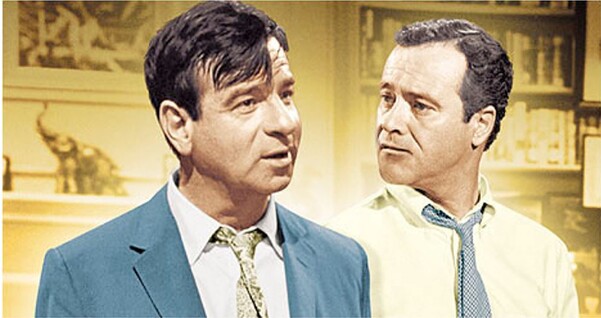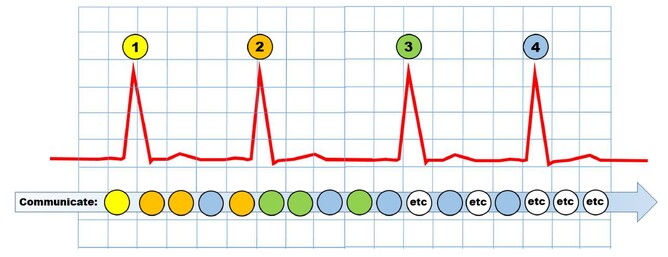Have The Odd Couple got hold of your brand? Are you communicating in one way all year and then giving different messages when pitching for work?
This article explains how to bring your regular communications and formal pitch messages together to make the most of both:
This article explains how to bring your regular communications and formal pitch messages together to make the most of both:
(Apologies for those who don't know who these two jokers are: they are Walter Matthau and Jack Lemmon from the Oscar-nominated 1968 Odd Couple film – one of many adaptations of this famous play.)
It seems to me that some organisations behave like the Odd Couple in the way they approach their strategic communications programmes and the way they win work through formal procurement or tendering processes.
They have two entirely distinct personalities - and although they live in one (brand) house they go about things in totally different ways. One's a spiky, painful, uptight process that's always neat and tidy, constantly obsessed with deadlines and continuously fretting about the tiniest of details. The other can be more of a flowing programme that sees the bigger picture and has the freedom to build over time while maximising opportunities as they come up.
And, despite the fact that that they share space, they can operate independently of one another – and cause tension in doing so. Which one is leading the other? And do they both even deliver the same messages (and evidence) about your brand?
To look at it another way, you could view an annual tendering process like a heart monitor: an intense series of spiky periods of submissions work when you are called upon to showcase your company's skills, capabilities and attributes:
It seems to me that some organisations behave like the Odd Couple in the way they approach their strategic communications programmes and the way they win work through formal procurement or tendering processes.
They have two entirely distinct personalities - and although they live in one (brand) house they go about things in totally different ways. One's a spiky, painful, uptight process that's always neat and tidy, constantly obsessed with deadlines and continuously fretting about the tiniest of details. The other can be more of a flowing programme that sees the bigger picture and has the freedom to build over time while maximising opportunities as they come up.
And, despite the fact that that they share space, they can operate independently of one another – and cause tension in doing so. Which one is leading the other? And do they both even deliver the same messages (and evidence) about your brand?
To look at it another way, you could view an annual tendering process like a heart monitor: an intense series of spiky periods of submissions work when you are called upon to showcase your company's skills, capabilities and attributes:
Like drinking too many cans of energy drink, the experience can be debilitating, so in the gaps between the major heartbeats the company can fall back to a business-as-usual 'do we have to?' mode of infrequent communication.
And this is not helped by the fact that somewhere alongside (or over, or under) this rollercoaster sit the marketing and communications programmes. Are these three even run by the same people? Sometimes yes, sometimes no. Do they talk to each other? Sometimes yes, sometimes no.
How to prevent The Odd Couple taking over
The companies I work with that prevent The Odd Couple Syndrome most effectively bring all the programmes together so that each feeds off the other: the marketers and communicators speak to the BD people who target the formal tender opportunities, identifying big tenders to be won during the year - and, collaboratively, planning their relationship, marketing and comms work together over the year to showcase the company's attributes.
All this so that they act, deliver, showcase and project the company's skills and activities in the best possible ways, and to make the most of the opportunities yet to come.
Therefore, I always recommend that an effective strategy involves thinking ahead of the coming year (or further, if you can) to:
And this is not helped by the fact that somewhere alongside (or over, or under) this rollercoaster sit the marketing and communications programmes. Are these three even run by the same people? Sometimes yes, sometimes no. Do they talk to each other? Sometimes yes, sometimes no.
How to prevent The Odd Couple taking over
The companies I work with that prevent The Odd Couple Syndrome most effectively bring all the programmes together so that each feeds off the other: the marketers and communicators speak to the BD people who target the formal tender opportunities, identifying big tenders to be won during the year - and, collaboratively, planning their relationship, marketing and comms work together over the year to showcase the company's attributes.
All this so that they act, deliver, showcase and project the company's skills and activities in the best possible ways, and to make the most of the opportunities yet to come.
Therefore, I always recommend that an effective strategy involves thinking ahead of the coming year (or further, if you can) to:
- Target the clients to whom you wish to get closer, and
- Identify the bids you are really looking to win from these clients - then
- Really understand their company objectives, plus the values and ways of doing things that they hold dear
- Focus on the attributes they cherish most in their partners
- Then identify how you can do - and showcase - things within your own organisation that match their requirements, finding opportunities to tell stories about them along the way – and, most importantly - way before the tender you are targeting; like this:
To explain this image further: while you plan ahead for bids 2, 3 and 4, you should look to tell stories (news, awards, case studies etc) early on that showcase the attributes you'll need to demonstrate when you arrive at the formal bidding points for 2, 3 and 4.
If you do this, then you can position your own company in the eyes of your targeted client as an aligned and proactive partner that is already doing the things that they like, acting genuinely to showcase your capabilities, behaviours and achievements in a way that matches the aspirations of your intended client.
Remember: tenders are never the time to introduce yourself to your client for the first time
The goal of this approach is for your intended client to come to know you - your skills, people, achievements and way of doing things – way before you get to the formal process.
After all, the formal documentation process should in many ways be about:
Ask yourself 5 simple questions:
Think ahead. Tell stories. Have fun – and win.
George Hulbert
If you do this, then you can position your own company in the eyes of your targeted client as an aligned and proactive partner that is already doing the things that they like, acting genuinely to showcase your capabilities, behaviours and achievements in a way that matches the aspirations of your intended client.
Remember: tenders are never the time to introduce yourself to your client for the first time
The goal of this approach is for your intended client to come to know you - your skills, people, achievements and way of doing things – way before you get to the formal process.
After all, the formal documentation process should in many ways be about:
- Them - wanting you to do well in the process (and even for you to win the work)
- You - proving to the client what they already know about you, because you have already shown it to them
- You using the past tense, not the future tense: "We have already delivered", "our approach is proven through" etc, is always much more effective than "we will show you that…"
Ask yourself 5 simple questions:
- What major bids are coming up this year that we want to target?
- What skills do we need to demonstrate to position ourselves well before this opportunity comes up?
- How can we demonstrate through action and evidence that we live the values we espouse?
- How can we demonstrate through action and case studies NOW the values and skills that we need to show to win the big bid?
- How can we enter awards to gain recognition of the skills and ways of doing things that are our hallmark?
Think ahead. Tell stories. Have fun – and win.
George Hulbert



